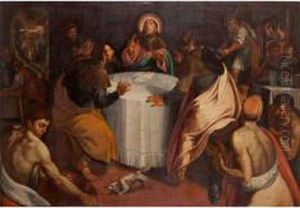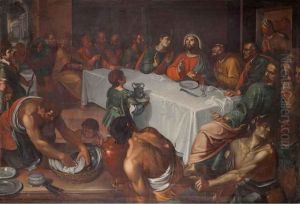Tiburzio Passerotti Paintings
Tiburzio Passerotti was an Italian painter and draftsman, born in Bologna in 1521. His contributions to art are often associated with the Mannerist movement, which was characterized by its complex compositions, elongated forms, and vibrant colors. Passerotti initially trained under local artists in Bologna before expanding his artistic education by studying the works of prominent Renaissance artists in Rome. His early career was marked by the influence of these Roman experiences, which is evident in his adept use of perspective and a keen attention to anatomical accuracy.
Upon returning to Bologna, Passerotti established himself as a prominent figure in the local art scene. He was known for his religious and mythological scenes, which were infused with a dynamic sense of movement and an intricate play of light and shadow. However, what truly set Passerotti apart from his contemporaries was his pioneering work in genre painting. He was one of the early Italian artists to focus on scenes of everyday life, bringing to the forefront subjects that were previously considered unworthy of high art. These works displayed a remarkable attention to detail and a lively depiction of the Bolognese society of his time.
Passerotti was also a respected portraitist, capturing the likenesses of many important figures of his era with psychological depth and realism. His portraits are noted for their sophisticated use of color and texture, which added a layer of vibrancy and immediacy to his subjects. Beyond his paintings, Passerotti contributed to the artistic landscape through his drawings and engravings, showcasing his versatility and skill in various mediums.
His workshop in Bologna became a center for artistic training and attracted numerous students, ensuring that his techniques and stylistic approaches were passed down to future generations. Passerotti's influence extended beyond his immediate circle, impacting the development of Baroque art in the region.
Tiburzio Passerotti died in 1592, leaving behind a legacy that was integral to the transition between the Renaissance and Baroque periods in Italian art. His work continues to be celebrated for its innovation, mastery of form, and the unique blend of traditional and genre subjects. Passerotti's contributions to Italian art are preserved in various museums and private collections, offering insight into the rich cultural and artistic milieu of 16th-century Italy.

